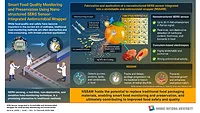Researchers Develop Portable Color-Changing Food Spoilage Sensor

Credit: Polina Tankilevitch via Pexels
When foods such as fish, meat, and cheese decompose, they release a variety of low molecular-weight organic nitrogen compounds known as biogenic amines (BAs). While the body uses BAs in small amounts for processes like hormone synthesis, ingesting large amounts of BAs from spoiled food can cause negative health consequences. Therefore, it is important to detect BAs during food storage and distribution.
To address the food safety issue of spoilage leading to the presence of BAs, a team of researchers at Pusan National University in Busan, South Korea developed a portable molecular sensor that quickly detects the presence of BAs and alerts users by changing colors. Led by Sungbaek Seo, Ph.D., the research team leveraged the distinct color-changing property of polydiacetylene (PDA)-based hydrogel beads that bind with BAs, combined with an alginate solution to render a three-dimensional porous structure with a large surface area.
The researchers were able to demonstrate the ability of the sensor beads to easily detect biogenic amines like cadaverine and propylamine, both in solution and vapor forms, via distinct changes in color from blue to red. The team tested the sensor against spoiled pork meat samples left at room temperature over a span of four days. Results showed that the sensor beads could efficiently track gradual spoilage over time through shifting shades of color.
The portable, lightweight sensor beads could be used for onsite monitoring during storage and throughout the supply chain. Furthermore, the beads could be employed to evaluate whether ideal food storage and distribution conditions are being maintained.
Looking for quick answers on food safety topics?
Try Ask FSM, our new smart AI search tool.
Ask FSM →








.webp?t=1721343192)